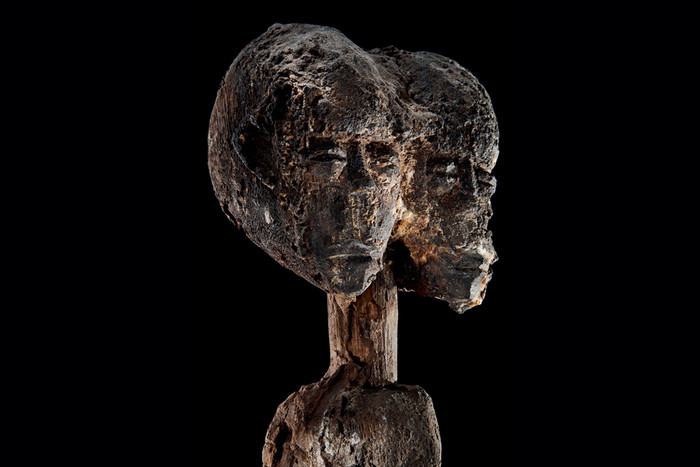Vaudou
05 Apr - 25 Sep 2011
VAUDOU
5 April - 25 September, 2011
“FOR THE PRIMITIVE ARTS AND MOST NOTABLY FOR VODUN, THERE IS JACQUES KERCHACHE AND ONLY HIM.” ANDRÉ MALRAUX
The Fondation Cartier pour l’art contemporain will present for the first time an exceptional group of vodun objects from the collection Anne and Jacques Kerchache, in a scenography conceived by Enzo Mari, one of the great masters of Italian industrial design. The exhibition is organized in close collaboration with Anne Kerchache—today Mrs. Kamal Douaoui—who was the wife of Jacques Kerchache until his death in 2001.
Jacques Kerchache and the Fondation Cartier pour l’art contemporain
An artistic advisor and curator of exhibitions, Jacques Kerchache was a strong advocate of the Primitive Arts, promoting their entry into important French museum collections. It was under his initiative that the Pavillon des Sessions was created at the Louvre in 2001, as well as the musée du quai Branly in 2006. Jacques Kerchache also collaborated with the Fondation Cartier on many occasions, first on the thematic exhibitions À visage découvert (1992) and être nature (1998) as well as on the solo show of the Haitian artist Patrick Vilaire in Réflexion sur la mort (1997).
The Vodun, African Voodoo Exhibition
Following these collaborations, Jacques Kerchache and the Fondation Cartier considered organizing an exhibition on voodoo statuary, but this project was postponed after his passing in 2001. On the tenth anniversary of his death the Fondation Cartier will uncover the fascinating and secret world of voodoo that was Jacques Kerchache’s lifelong passion. Through the Vodun, African Voodoo exhibition, the Fondation Cartier will thus pay homage to this great expert and explorer known for his exacting eye, a connoisseur of both Primitive and Contemporary Art.
The Art of Voodoo
As early as the late sixties, Jacques Kerchache recognized the aesthetic potency and stunning originality of voodoo statuary and its forms. It was at this time, during his first trips to the birthplace of voodoo currently known as the Republic of Benin, that he began to bring together what has become the most significant existing collection of African voodoo statuary. The exhibition will present approximately hundred objects, including some that now belong to other private collectors.
Objects of Religious Cult
An anthropomorphic assemblage of materials such as ropes, bones, shells, and pottery, voodoo sculptures assume a critical role in the practice of this ancient religious cult, still active today from the coasts of Togo to Western Nigeria. Covered with a thick layer of matter includes earth, palm oil and powder, these strange and uncanny sculptures emanate qualities of tension and foreboding. Their ambiguous aesthetics are closely linked to their role in both protecting their owners from danger and harming those responsible for their difficulties.
Through its silent simplicity and meditative rigour, the exhibition will allow these impenetrable objects to speak for themselves, thus revealing the mystery and convulsive beauty of voodoo statuary.
5 April - 25 September, 2011
“FOR THE PRIMITIVE ARTS AND MOST NOTABLY FOR VODUN, THERE IS JACQUES KERCHACHE AND ONLY HIM.” ANDRÉ MALRAUX
The Fondation Cartier pour l’art contemporain will present for the first time an exceptional group of vodun objects from the collection Anne and Jacques Kerchache, in a scenography conceived by Enzo Mari, one of the great masters of Italian industrial design. The exhibition is organized in close collaboration with Anne Kerchache—today Mrs. Kamal Douaoui—who was the wife of Jacques Kerchache until his death in 2001.
Jacques Kerchache and the Fondation Cartier pour l’art contemporain
An artistic advisor and curator of exhibitions, Jacques Kerchache was a strong advocate of the Primitive Arts, promoting their entry into important French museum collections. It was under his initiative that the Pavillon des Sessions was created at the Louvre in 2001, as well as the musée du quai Branly in 2006. Jacques Kerchache also collaborated with the Fondation Cartier on many occasions, first on the thematic exhibitions À visage découvert (1992) and être nature (1998) as well as on the solo show of the Haitian artist Patrick Vilaire in Réflexion sur la mort (1997).
The Vodun, African Voodoo Exhibition
Following these collaborations, Jacques Kerchache and the Fondation Cartier considered organizing an exhibition on voodoo statuary, but this project was postponed after his passing in 2001. On the tenth anniversary of his death the Fondation Cartier will uncover the fascinating and secret world of voodoo that was Jacques Kerchache’s lifelong passion. Through the Vodun, African Voodoo exhibition, the Fondation Cartier will thus pay homage to this great expert and explorer known for his exacting eye, a connoisseur of both Primitive and Contemporary Art.
The Art of Voodoo
As early as the late sixties, Jacques Kerchache recognized the aesthetic potency and stunning originality of voodoo statuary and its forms. It was at this time, during his first trips to the birthplace of voodoo currently known as the Republic of Benin, that he began to bring together what has become the most significant existing collection of African voodoo statuary. The exhibition will present approximately hundred objects, including some that now belong to other private collectors.
Objects of Religious Cult
An anthropomorphic assemblage of materials such as ropes, bones, shells, and pottery, voodoo sculptures assume a critical role in the practice of this ancient religious cult, still active today from the coasts of Togo to Western Nigeria. Covered with a thick layer of matter includes earth, palm oil and powder, these strange and uncanny sculptures emanate qualities of tension and foreboding. Their ambiguous aesthetics are closely linked to their role in both protecting their owners from danger and harming those responsible for their difficulties.
Through its silent simplicity and meditative rigour, the exhibition will allow these impenetrable objects to speak for themselves, thus revealing the mystery and convulsive beauty of voodoo statuary.

